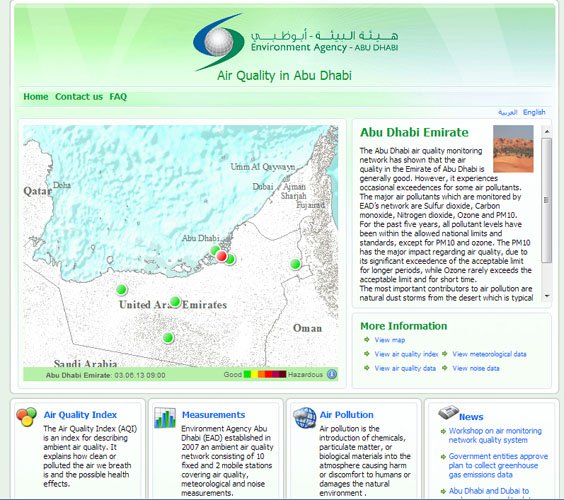ID :
287862
Mon, 06/03/2013 - 13:46
Auther :
Shortlink :
https://www.oananews.org//node/287862
The shortlink copeid
EAD and HAAD encourage public to visit website to avoid effects of dust storms

Abu Dhabi, June 3, 2013 (WAM) - The Environment Agency, Abu Dhabi (EAD) and the Health Authority - Abu Dhabi (HAAD) are encouraging the community to visit http://www.adairquality.ae to understand how best to avoid the effects of dust storms, which are largely natural phenomena, on their children's health.
To ensure that the community has access to important air quality information, EAD has developed a website where data from EAD's 20 air quality monitoring stations, scattered around Abu Dhabi Emirate, are transmitted live, 24 hours a day. The data collected allows EAD to monitor and measure five major air pollutants: particle pollution (also known as particulate matter), nitrogen dioxide, carbon monoxide, sulphur dioxide and ground-level ozone.
Dust storms can trigger asthmatic attacks, especially if one is not prepared in advance. However, by properly monitoring the environment and managing their behaviour, people can enjoy a good quality of life. Without care, asthma sufferers can experience recurring episodes of wheezing, breathlessness, chest tightness and coughing, particularly at night or in the early morning.
In the UAE, asthmatics need to be aware of and try to avoid allergens, like dust mites in humid areas, and particulate matter in the air, like dust and smoke or smog. Air quality scientists call this PM10, or particulate matter smaller than 10 microns, which is approximately the thickness of a human hair.
"One of our strategic priorities at EAD is to ensure that the Emirate's air is clean. Our research indicates that the key cause of poor air quality in the Emirate of Abu Dhabi is due to a natural cause; desert dust storms. So whilst keeping an eye on these dust storms, we are also controlling and regulating industrial air discharges," said Eng. Sheikha Ahmed Al Hosani, Acting Director of Environmental Monitoring and Analysis Division, at EAD's Environmental Quality Sector.
By visiting the website, one can identify where EAD's air quality monitoring stations are located across the Emirate of Abu Dhabi and better understand the status of air quality at these areas. The website highlights the status of air quality through six clearly-defined levels of health concern: good, moderate, unhealthy for sensitive groups, unhealthy, very unhealthy and hazardous.
"If you have a respiratory problem, then on the days when dust storms are severe it is advisable to avoid areas classified as Unhealthy for Sensitive Groups or above by staying indoors and continue to take your regular medication," said Dr. Khaled Al Jaberi, Department Manager, Non-Communicable Disease, Health Authority - Abu Dhabi. – Emirates News Agency, WAM





